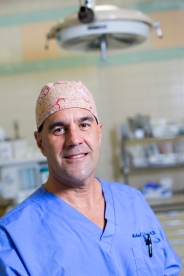Brighter Days for Ambulatory Surgery Centers with Innovative Breast Care
Ambulatory surgery centers face plenty of financial (some might even say “existential”) challenges. Among these are a tightening reimbursement environment, competition from hospital systems, and high health insurance deductibles.

Dr. Michael Cross is establishing an international reputation for innovations in breast cancer surgery.
Nonetheless, breast cancer care is emerging as a bright spot for ASCs, including two centers we talked with recently.
In a large New York City surgery center, for example, breast care helps lead the way. In an Arkansas center, transparent pricing and use of a relatively new surgical marker called BioZorb are part of the story.
First, though, let’s talk about those challenges.
“The changes in healthcare have been accelerated with passage of the 2010 Affordable Care Act, a.k.a. Obamacare, the expansion of Medicaid programs, an economy that is improving at a slower than normal rate, and stagnant increases in wages,” Laura Dyrda wrote recently in Becker’s ASC Review, “Reimbursement is in flux for many surgical specialties,” and high-deductible
health plans – which are growing ever more common – create greater payment challenges.
health plans – which are growing ever more common – create greater payment challenges.
Another elephant in the room is consolidation among providers. Hospital systems are scarfing up physician practices and turning doctors into employees. That alters referral patterns. It incentivizes hospitals and doctors to keep surgeries within their system rather than referring them to ASCs.
Now back to the bright spot of breast cancer care.
Gramercy Surgery Center, with offices in Manhattan and Queens, has an initiative to provide “ambulatory cancer care.” Leading that effort, says COO Jeffrey Flynn, is high-quality breast cancer care.
Gramercy Surgery Center, with offices in Manhattan and Queens, has an initiative to provide “ambulatory cancer care.” Leading that effort, says COO Jeffrey Flynn, is high-quality breast cancer care.
Rather than do lumpectomies in an expensive hospital setting, Gramercy’s four breast surgeons perform routine breast -conserving surgeries (in patients with no comorbidities and no need for lymph node dissection, for example) in a setting that is less than one-quarter the cost of a hospital operating room. In New York, Flynn puts the cost of Gramercy’s OR at $900 an hour, versus $4,100 an hour for a hospital OR.
Yes, Gramercy has competition from some hospitals that want to retain patients, Flynn acknowledges. But he quickly adds that many hospitals doing the math find they are in fact better off by referring some breast surgeries to an ambulatory center.
Gramercy both features its physicians in marketing efforts — including luminaries such as Dr. John Kehoe – and also sees its surgeons as clients in themselves. Happy doctors are more likely to deliver high-quality care, the thinking goes. Plus they will bring patients with them for future surgery those patients may need.
Flynn and colleagues make a point of stressing the financial effectiveness of their centers when they talk to payers. They partner with hospitals in some cases. And for patients, they emphasize the many advantages an ASC has over a typical big-city hospital. Those include lower complication rates and a calmer, boutique-type atmosphere.
Another innovative ASC, North Hills Surgery Center in Arkansas, adds other advantages to the list that ambulatory centers have in breast care.
North Hills is one of the few facilities in the country that actually posts its rates on its website. That kind of price transparency is appreciated by both patients and payers alike. This is especially true in an era of high deductibles, which many patients have to cover themselves. Insurers like it, too, in their never-ending efforts to know exactly what they are covering and what it costs.
North Hills also has the advantage of working closely with Dr. Michael Cross. He’s establishing an international reputation for innovative breast cancer surgery using theBioZorb surgical marker. Working within the ASC setting, Dr. Cross has placed well over 130 of these markers in lumpectomy patients.
BioZorb has a key role to play in the emerging trend of oncoplastic surgery, in what its co-inventor, Dr. Gail Lebovic, calls a “reconstructive lumpectomy.” By adding volume in the tumor bed once the cancer is excised, the 3D marker helps reduce the dimpling and deformity that can too often result from a lifesaving lumpectomy.
The marker is also used to mark the tumor site for follow-up radiation and for future monitoring with mammograms and other forms of imaging. BioZorb has been linked instudies to the ability to do shorter courses of radiation.
When it’s used to more precisely mark the location of the tumor bed, Dr. Cross and colleagues have reported, they can shorten the length – and reduce the cost — of radiation treatment, using hypofractionated radiotherapy. For eligible patients, that means they don’t have to come in for the traditional, lengthy six weeks of radiation.
These successes at Gramercy and North Hills – in the Big Apple and in the middle America of Fayetteville, Ark. — demonstrate that despite all the tumultuous changes in healthcare, it’s not necessarily dark days for ASCs. In fact, with a strong focus on patients, innovative technology such as BioZorb, and the right combination of surgeons and facilities, brighter days are readily achievable.

No comments:
Post a Comment